 |
 |
 |
TDLC GOES GLOBAL:
TDLC hosts global Science of Learning Conference
 The meeting, held Feb. 8-10, 2018 and focusing on improving education for children, and the role of science in learning, was hosted by TDLC and organized by Drs. Andrea Chiba and Leanne Chukoskie. The event attracted a diverse, global group of participants, including NSF Directors, members of NSF’s Beijing office in China, the Brazilian Science of Learning Network, and members from well-known non-profit organizations such as the Bill and Melinda Gates Foundation and the Alliance for Excellent Education. In addition, First Lady of Virginia Pamela Northam attended, as did former Governor of West Virginia, Bob Wise. The meeting, held Feb. 8-10, 2018 and focusing on improving education for children, and the role of science in learning, was hosted by TDLC and organized by Drs. Andrea Chiba and Leanne Chukoskie. The event attracted a diverse, global group of participants, including NSF Directors, members of NSF’s Beijing office in China, the Brazilian Science of Learning Network, and members from well-known non-profit organizations such as the Bill and Melinda Gates Foundation and the Alliance for Excellent Education. In addition, First Lady of Virginia Pamela Northam attended, as did former Governor of West Virginia, Bob Wise.
NSF Program Director Soo-Siang Lim praised the event for its ability to bring the Science of Learning community "to the 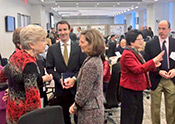 next level of engagement and involvement." She added, "The overwhelming interest generated by this meeting is gratifying – and eye-opening as well, to the potential opportunities in other public/private sectors that can be leveraged towards our shared goals.” More from Qualcomm Institute article next level of engagement and involvement." She added, "The overwhelming interest generated by this meeting is gratifying – and eye-opening as well, to the potential opportunities in other public/private sectors that can be leveraged towards our shared goals.” More from Qualcomm Institute article To view the conference agenda, click here. To view the conference agenda, click here.
|
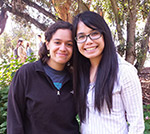 TDLC COMES FULL CIRCLE TDLC COMES FULL CIRCLE
TDLC's final San Diego Fellow, Pamela Rivière, receives an NSF Graduate Research Fellowship to work with former TDLC Fellow Lara Rangel
The Temporal Dynamics of Learning Center (TDLC) has always valued mentorship and collaboration. More than 150 students have participated in Center laboratories across 18 research institutions in four countries (U.S., Canada, England, and Australia)! A great example is the mentorship between Dr. Andrea Chiba, former trainee Dr. Lara Rangel (above, right), and current student Pamela Rivière (above, left). More 
 Mindshift: Another successful MOOC Mindshift: Another successful MOOC
Drs. Terry Sejnowski and Barbara Oakley's massive online open course (MOOC) for Coursera called "Learning How to Learn," is currently the most popular MOOC from major universities around the world. In April 2017, Drs. Sejnowski and Oakley launched a companion course, "Mindshift: Break Through Obstacles to Learning and Discover Your Hidden Potential." This new course is designed to "help boost your career and life in today’s fast-paced learning 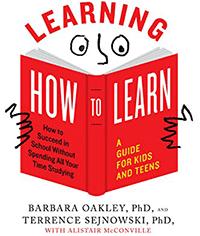 environment." They offer mental tools and practical insights from science on things like how to work with mentors, the secrets to avoiding life ruts, and how to learn and change effectively. The course is already on the list of the top 50 MOOCS! To broaden access, they began writing a "Learning How to Learn" book for kids and teens, to be available in August 2018. In addition, they are working on a Learning How to Learn MOOC for children, sponsored by Arizona State University and due out in Fall 2018, as well as a version of the adult Learning How to Learn in Chinese. Read more about the history of Learning How to Learn environment." They offer mental tools and practical insights from science on things like how to work with mentors, the secrets to avoiding life ruts, and how to learn and change effectively. The course is already on the list of the top 50 MOOCS! To broaden access, they began writing a "Learning How to Learn" book for kids and teens, to be available in August 2018. In addition, they are working on a Learning How to Learn MOOC for children, sponsored by Arizona State University and due out in Fall 2018, as well as a version of the adult Learning How to Learn in Chinese. Read more about the history of Learning How to Learn 
|
|

|
 Therapeutic Games for Improving Low-Level Attention Therapeutic Games for Improving Low-Level Attention
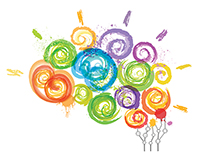 Dr. Jeanne Townsend and Dr. Leanne Chukoskie saw the need to take research findings about attention and to translate them into effective, affordable and readily available interventions. Through their new company, BrainLeap, they have created interventions in the form of fun games, aimed at improving attention. Dr. Jeanne Townsend and Dr. Leanne Chukoskie saw the need to take research findings about attention and to translate them into effective, affordable and readily available interventions. Through their new company, BrainLeap, they have created interventions in the form of fun games, aimed at improving attention.
More 
 The Role of Music in Science Education The Role of Music in Science Education
Listening to Waves is an educational program that seeks to engage youth in STEM by teaching them the science of waves through the creation of electronic sounds and musical instruments. The program is an upshot of Dr. Victor Minces’ and Dr. Alex Khalil’s TDLC work investigating the role of music in education. The program is now supported by the EHR division of the National Science Foundation. Since its inception, Listening to Waves has served more than 1300 students, largely from low SES populations. More 
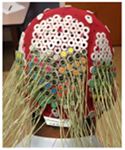 Very high density EEG elucidates spatiotemporal aspects of early visual processing Very high density EEG elucidates spatiotemporal aspects of early visual processing
TDLC's Marlene Behrmann and Michael Tarr at Carnegie Mellon University (with Pulkit Grover, Shawn Kelly, and Amanda Robinson as lead author) showed that whereas standard human EEG systems based on spatial Nyquist estimates suggest that 20-30 mm electrode spacing suffices to capture neural signals on the scalp, “super-Nyquist” density EEG (“SND”) with Nyquist density (“ND”) arrays can capture neural signals, especially in the high frequency range, with greater accuracy. More 
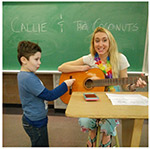
CARTE Academy for Children on the Autism Spectrum
In the fall of 2017, the Centre for Autism Research, Technology, and Education (CARTE) at the University of Victoria launched a new (FREE) monthly series of half-day camps for children on the autism spectrum. The activities are fun and educational, and in a setting that allows campers a better chance to develop friendships with other campers and camp staff. More  |
|
|
| |
| |
|
This message was sent from:
The Temporal Dynamics of Learning Center (TDLC.UCSD.EDU),
University of California, San Diego,
9500 Gilman Drive, La Jolla, CA 92093
To learn more about TDLC, please visit us on the web at: TDLC.UCSD.EDU
Please contact webmaster@tdlc.ucsd.edu to unsubscribe.
TDLC is a Science of Learning Center (SLC),
one of six SLCs funded by the National Science Foundation. NSF grant #SMA 1041755
|
|
 |
 |
June 2018 |
|
| |
|
 |
 |
Grafted brain organoids provide insight into neurological disorders
Salk scientists improve the growth of three-dimensional brain models to better understand autism, dementia, schizophrenia
TDLC's Dr. Fred Gage is part of the study team. (Salk, 4/16/18) More |
 |
Making new memories is a balancing act
Salk scientists discover that brain storage capacity is dynamic and varies by region. Dr. Terry Sejnowski is one of the authors of this new paper. (Salk Institute, 3/14/18) More
|
 |
15 Coolest Jobs in San Diego and How to Get Them
TDLC investigator Leanne Chukoskie is featured in the article! (San Diego Magazine, 1/2/18) More
|
 |
Dr. Jim Tanaka Receives Provost's Engaged Scholar Award
TDLC Investigator Jim Tanaka, Ph.D., along with scientist Jutta Gutberlet, Ph.D., have been awarded the University of Victoria Provost’s Engaged Scholar Award. The award is presented to tenured faculty who have demonstrated outstanding scholarship in their field, as well as inspired teaching and community engagement. More
|
 |
TDLC researchers Dr. Marlene Behrmann and Dr. Michael Tarr are part of a team that was awarded a grant from The Chuck Noll Foundation For Brain Injury Research.
Their grant, "Automated Detection and Suppression of Brain Tsunamis," involves a three-year study to develop a novel system for concussion monitoring and treatment. (BusinessWire, 2/22/18) More
|

|

Our Brain’s Inner Clock
Unlike our sense of touch, sight, smell, hearing, or taste, our ability to sense time doesn’t have a central node in the brain or single mode of action. Instead, we sense time through a broadly distributed network of neurons, which can encode time across scales ranging from milliseconds to days.
In addition, our sense of time interacts with emotions -- for example, stress can affect our perception of time. Read more about our brain's inner clock!
Credit: Knowing Neuron
|
|
|
|
 |

![]()
